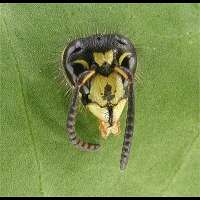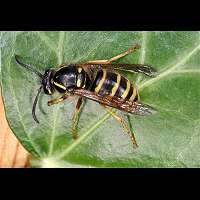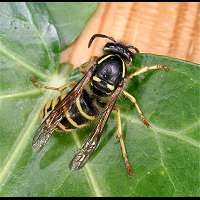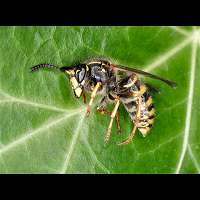Dolichovespula adulterina
Dolichovespula adulterina is a black wasp with a yellow pattern of lines. The species is extremely similar to the Saxon Wasp. And just like in the Saxon Wasp the markings on the clypeus are variable. The hairs on the thorax though have one colour mainly: they are blond. Males can only be identified by looking at them under a microscope, which is true for all Dolichovespula males. The body of the female reaches a length of 14 to 17mm. Males remain slightly smaller and reach a bodily length of 12 to 15mm.
Dolichovespula adulterina is a cuckoo wasp. This means it doesn't make its own nest, but simply takes over an existing one. The workers of the existing nest are used to bring up the cuckoo wasp's young. Cuckoo wasps thus only have females and males and no workers. Dolichovespula adulterina takes over the nest of a Saxon Wasp. The female waits until the nest is developed completely and there are enough workers in it. Then she makes her entrance in the nest and tries to kill the Saxon Wasp's queen. Of course the queen tries to sting the intruder, but Dolichovespula adulterina has an unsusual thick chitine skin and she can withstand a lot. That's why the attack on the queen is succesfull many times. The queen is killed and the cuckoo takes over. She starts by killing all eggs and larvae of the Saxon Wasp. Next she deposists her own eggs. The Saxon Wasp workers take care of the eggs like they are their own. Once the larvae hatch, the workers provide them with all the food they need. But once all are adult, the party is over. The workers are worn out and start dying. And as there is no more Saxon wasp queen, the workers are not replaced. So the nest slowly becomes empty. The new cuckoo wasps however have already left the nest and mated. Soon the males will die and the females will look for a place to hibernate. By the end of August all females are fast asleep, not to be woken until May or June next year! The sting of Dolichovespula adulterina may be lethal for Saxon Wasps, for humans it is one of the most painless wasp stings.
Dolichovespula adulterina is quite common in Europe, Northern and Central Asia and Japan. Absent from the British Isles though. It is common wherever the Saxon Wasp is. This species is very seldom seen, not because it is rare, but because it is so difficult to identify.
Dolichovespula adulterina is a black wasp with a yellow pattern of lines. The species is extremely similar to the Saxon Wasp. And just like in the Saxon Wasp the markings on the clypeus are variable. The hairs on the thorax though have one colour mainly: they are blond. Males can only be identified by looking at them under a microscope, which is true for all Dolichovespula males. The body of the female reaches a length of 14 to 17mm. Males remain slightly smaller and reach a bodily length of 12 to 15mm.
Dolichovespula adulterina is a cuckoo wasp. This means it doesn't make its own nest, but simply takes over an existing one. The workers of the existing nest are used to bring up the cuckoo wasp's young. Cuckoo wasps thus only have females and males and no workers. Dolichovespula adulterina takes over the nest of a Saxon Wasp. The female waits until the nest is developed completely and there are enough workers in it. Then she makes her entrance in the nest and tries to kill the Saxon Wasp's queen. Of course the queen tries to sting the intruder, but Dolichovespula adulterina has an unsusual thick chitine skin and she can withstand a lot. That's why the attack on the queen is succesfull many times. The queen is killed and the cuckoo takes over. She starts by killing all eggs and larvae of the Saxon Wasp. Next she deposists her own eggs. The Saxon Wasp workers take care of the eggs like they are their own. Once the larvae hatch, the workers provide them with all the food they need. But once all are adult, the party is over. The workers are worn out and start dying. And as there is no more Saxon wasp queen, the workers are not replaced. So the nest slowly becomes empty. The new cuckoo wasps however have already left the nest and mated. Soon the males will die and the females will look for a place to hibernate. By the end of August all females are fast asleep, not to be woken until May or June next year! The sting of Dolichovespula adulterina may be lethal for Saxon Wasps, for humans it is one of the most painless wasp stings.
Dolichovespula adulterina is quite common in Europe, Northern and Central Asia and Japan. Absent from the British Isles though. It is common wherever the Saxon Wasp is. This species is very seldom seen, not because it is rare, but because it is so difficult to identify.








